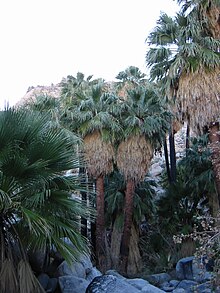California Fan Palm
| Washingtonia filifera | |
|---|---|
 |
|
| Washingtonia filifera in native grove near Twentynine Palms, California. | |
| Scientific classification | |
| Kingdom: | Plantae |
| (unranked): | Angiosperms |
| (unranked): | Monocots |
| (unranked): | Commelinids |
| Order: | Arecales |
| Family: | Arecaceae |
| Genus: | Washingtonia |
| Species: | W. filifera |
| Binomial name | |
|
Washingtonia filifera (Lindl.) H.Wendl. |
|
 |
|
| Natural range | |
| Synonyms | |
|
|
Washingtonia filifera, also known as desert fan palm, California fan palm or California palm, is a flowering plant in the palm family (Arecaceae), and native to the southwestern U.S. and Baja California. Growing to 15–20 m (49–66 ft) tall by 3–6 m (10–20 ft) broad, it is an evergreen monocot with a tree-like growth habit. It has a sturdy columnar trunk and waxy fan-shaped (palmate) leaves.
Other common names include California fan palm and petticoat palm. The specific epithet filifera means "thread-bearing".
Washingtonia filifera is the only palm native to the Western United States and the country's largest native palm.
Primary populations are found in desert riparian habitats at spring-fed and stream-fed oases in the Colorado Desert and at a few scattered locations in the Mojave Desert. It is also found near watercourses in the Sonoran Desert along the Gila River in Yuma, along the Hassayampa River and near New River in Maricopa County, and in portions of Pima County, Pinal County, Mohave County (along the Colorado River) and several other isolated locations in Clark County, Nevada. It is a naturalized species in the warm springs near Death Valley and in the extreme northwest of Sonora (Mexico). It is also reportedly naturalized in the Southeast, Florida, Hawaii, the U.S. Virgin Islands, and Australia (New South Wales).
...
Wikipedia

